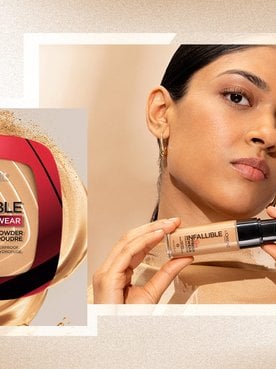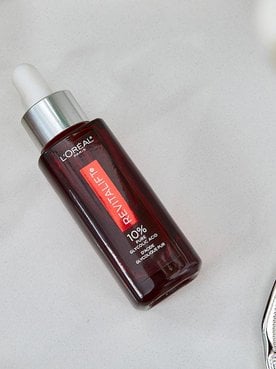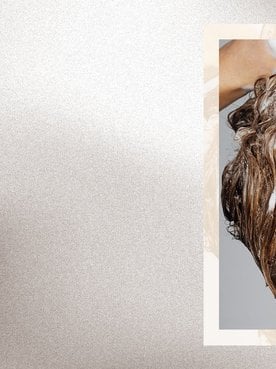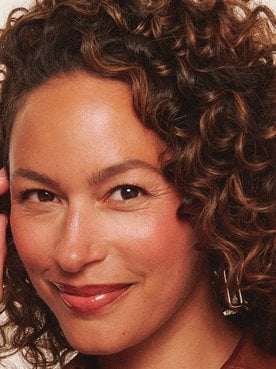At-home hair color technology seems to be more advanced than ever. Between balayage kits that can give you sunkissed strokes akin to a colorist’s and high-lift bleaches that enable you to go platinum from home, dyeing your hair has never been more convenient. But it’s about to get even easier.
L’Oréal Paris recently debuted the Colorsonic, a device that revolutionizes how you apply DIY hair dye. At the touch of a button, the first-of-its-kind device automatically mixes your dye, parts your hair, and evenly deposits color from root to tip for salon-worthy results. Ahead, we’re giving you all of the details about dyeing your hair with the innovative Colorsonic hair color device. We’re also providing pointers on using at-home hair dye, plus maintenance tips that can help keep your new hue as vibrant as possible.
How To Dye Your Hair at Home With Colorsonic
L’Oréal Paris spent more than 10 years developing the Colorsonic, which is the first device of its kind ever to hit the market (it has 29 patents to date, and was already named one of the top 100 inventions by TIME). The smart device brilliantly simplifies the process of dyeing your hair at home, eliminating the need to mix your own color or figure out how to apply it evenly. In the box, you’ll find the following:

- Colorsonic hair color device
- Instruction manual
- Rubber gloves
- Charger
- Lengths adaptor
- Color cleaning cartridge
With this lineup on hand, you can begin dyeing your hair. Three steps and five minutes are all it takes to get salon-quality results.
Step 1: Pick a color
Like with any hair dye, you’ll have to start by selecting your preferred color. To accompany the Colorsonic, L'Oréal Paris has also introduced the brand’s first multi-usage permanent hair color cartridge. You can use each color cartridge up to three times (one full head application or three root retouches), so there’s less chance of any precious formula going to waste.
And, the colors themselves are stunning. There are more than 20 rich, dimensional shades available in the collection, all of which are ammonia-free and formulated without silicones, parabens, SLS, SLES, or phthalates. The nourishing formulas are suitable for all hair types, textures, and lengths, and leave the hair looking (and feeling) healthy, with long-lasting expert color and shine.
Step 2: Pop in the color cartridge
Once you’ve picked your shade, insert your cardboard color cartridge into the Colorsonic hair color device and press the power button. The tool will automatically mix colorant and developer in a perfect 1:1 ratio for the freshest, non-oxidizing formula.

Step 3: Brush the wand through your hair
Now, you’re ready to start the actual hair dyeing application. Begin by placing the brush-like bristles of your Colorsonic wand at your hairline. Then, hold down the button as you stroke the device through the ends of your hair as if you were running an actual brush through it. With every pass, the oscillating smart bristles automatically part your hair while saturating your hair from root to tip with rich, high-quality color. The bristles can also adapt to your hair length and curl pattern, delivering the perfect amount of professional-grade color every time.
Shop the Products
Tips for Dyeing Your Hair at Home
Regardless of the method used to dye your hair, preparing for a new hair color generally remains the same. Heed the following advice to help make your next color transformation even more seamless.
Start with unwashed hair
Although dyeing both clean and dirty hair can yield the same color results, many pros recommend the latter if you have sensitive skin. This way, your scalp’s natural oils can build up and create a barrier between the dye and your skin, reducing the risk of irritation. If possible, try to wait two or three days after shampooing before coloring your hair.
Do a patch test
Speaking of irritation, carrying out a patch test can also be helpful to avoid any potential side effects. According to the National Health Service (NHS), the ingredients found in certain permanent dyes can cause a rashy, bumpy reaction known as contact dermatitis. As such, the NHS recommends swabbing a small amount of dye behind your ear or along your inner elbow, letting it dry, and seeing how your skin reacts. If the area appears red or inflamed when you remove it, do not use the product to color your hair.
Apply dye to dry hair
One of the biggest questions about at-home hair color is whether it’s better to dye your hair wet or dry. The short answer is that it depends on the formula. Some hair dyes, like demi-permanent and semi-permanent, can be applied to wet hair for an intentionally sheerer result. Permanent hair color, like those used with the Colorsonic hair color device, should typically be applied to dry tresses. The reason is that when hair is wet, moisture can dilute the chemicals that help alter your hair color on a deeper, more permanent level. Reducing the potency of these ingredients can result in dull or uneven coverage. As always, we advise reading the instruction label of your chosen hair dye before getting to work.
Set a timer
Hair dye application instructions often vary by shade, so it’s important to read the included label so you know how long your color needs to process. In addition, there are a few factors that can influence how long it takes for your hair dye to work. These can include your starting shade, hair texture (finer hair tends to process more quickly), and whether your hair is virgin or color-treated. Leaving your dye on longer than recommended can lead to overprocessed hair. We suggest setting a timer on your phone based on the dye’s instructions so you don’t go overboard. When the time is up, thoroughly rinse your dye until the water runs clear.
Who Should Try the L'Oréal Paris Colorsonic?
The Colorsonic hair color device is a game-changer for anyone who dyes their hair at home. However, It’s especially well-suited for those new to at-home hair coloring because it makes the process virtually effortless. With the Colorsonic, you don’t have to worry about mixing your dye and developer, parting your hair, or spending precious time ensuring a precise, even application—the device does all of that for you. It also does it quickly, requiring around five minutes to cover your entire head. Though you’ll still need to pencil in some time to let the color process, the Colorsonic can easily shave a half hour or more off of your at-home hair coloring routine, making it an excellent option for those with little time to spare.

What Color Should I Dye My Hair?
With so many gorgeous hair color trends floating around social media, choosing just one can feel overwhelming. But instead of thinking of a new hue in terms of light, medium, or dark, we recommend narrowing it down based on your skin’s undertones. Put simply, undertones are the subtle underlying pigments in your skin that influence its overall tone. Coordinating your hair color with your undertones can help illuminate your complexion versus washing out.
Undertones can be either cool, warm, or neutral, and determining yours is fairly easy: Turn your hand over and see whether the veins visible on the underside of your wrist appear green (warm), blue (cool), or a mix of both (neutral). With this knowledge in mind, you’ll want to select hair colors with the same undertone. For example, golden, caramel, and bronze hair colors look striking against warm-toned skin, while platinum blonde, jet black, and ash brown tend to pair well with cool-toned skin. If your undertones are neutral, you can try almost any hair color with flattering results. Use the L'Oréal Paris Virtual Foundation Matcher if you need more guidance on accurately assessing your skin tone, or take our Hair Color Quiz to find a range of shades that’ll work well for you.
Remember, these are just guidelines to consider and not strict rules. At the end of the day, you should pick a new hair color that makes you feel the most beautiful and empowered version of yourself.
How To Care For Dyed Hair
Learning how to dye your hair using the Colorsonic may be step one in achieving gorgeous salon-like results, but what comes next matters, too. After coloring your hair, it’s important to tweak your haircare routine to help maintain your new hue. Here’s how.
Pick up color-safe products
A color-safe, sulfate-free shampoo and conditioner is essential for keeping your dyed strands looking healthy and vibrant. Try the L’Oréal Paris EverPure Sulfate Free Bond Repair Shampoo and L’Oréal Paris EverPure Sulfate Free Bond Repair Conditioner to help preserve your color and repair your hair in one fell swoop. The duo, which features citric acid, penetrates inside the hair’s cortex to help rebuild weakened hair bonds from coloring services without dulling your color. As needed, pre-treat your strands with the L’Oréal Paris EverPure Bond Strengthening Pre-Shampoo Treatment for stronger, smoother-looking hair.
Shop the Products
Reduce heat styling
Limiting heat styling is one of the best ways to help reduce hair damage. However, if you still want to use hot tools to perfect your look, be sure to apply a heat protectant and turn your tools to their lowest temperature setting. We’re partial to our L’Oréal Paris EverPure Bond Repair Hair Oil-in-Serum—the multi-tasking formula helps strengthen weak hair, boosts shine, and protects against temperatures up to 450 degrees Fahrenheit. If you’re prone to frizz and flyaways, try using the L’Oréal Paris Elvive Dream Lengths Frizz Killer Serum Leave-In before styling your hair.
Shop the Products
Touch up your roots regularly
Hair grows about half an inch per month, on average, which means you’ll likely start noticing root regrowth after about four to six weeks. To keep your color looking fresh, we recommend setting aside time to touch up your roots once every one to two months. Each Colorsonic cartridge comes with enough product for one full head or three root applications, so you may be able to use what’s left over from your initial dye job. If not, grab a new cartridge and touch up your roots, or grab a temporary cover-up spray like the L’Oréal Paris Magic Root Cover-Up to camouflage regrowth until you’re ready to color your roots.
Shop the Products
Next Up: How To Dye Dark Hair Without Bleach
Photo Courtesy of L'Oréal Paris







